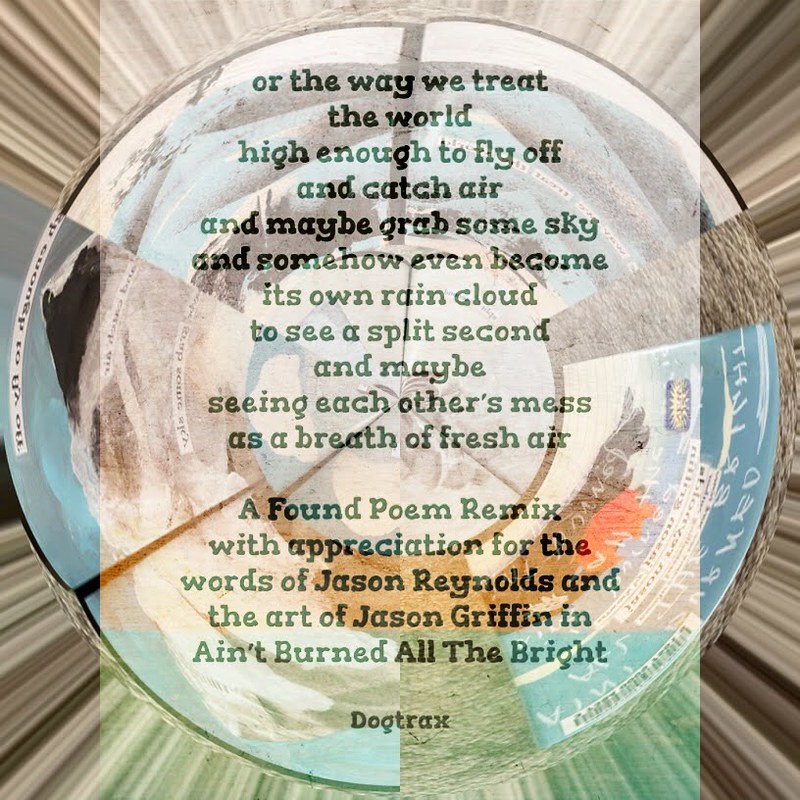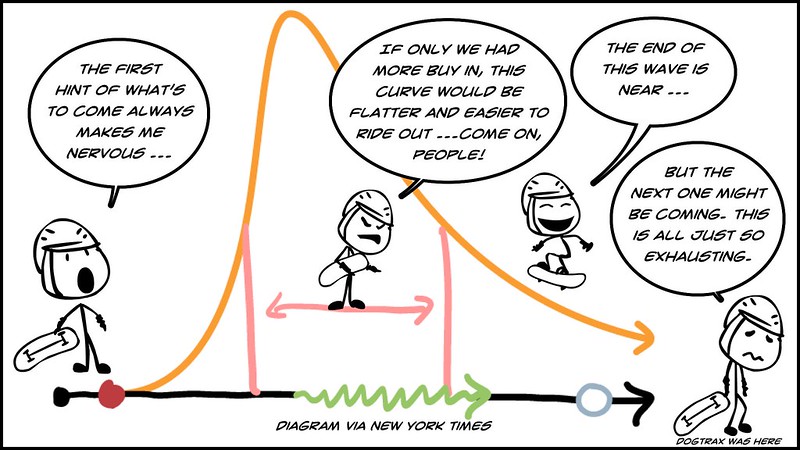Peace (and a smile),
Kevin
Poem: A Riff Upon Closer Listening
This is a response poem to Ain’t Burned All The Bright. You can read a better, larger version here.
Peace (in song),
Kevin
Remixing Ain’t Burned All The Bright (Found Poem)
Yesterday, I mentioned loving the new visual/text novel by writer Jason Reynolds and artist Jason Griffin — Ain’t Burned All The Bright — and after reading it multiple times, I realized that if you did random flipping through its pages, a poem would almost always emerge. (I started to read the book, thanks to a shared birthday invitation from two National Writing Project friends: Bryan Crandall and Paul Hankins).
Which led me to a remix that became a found poem. (above)
The words in the poem are all from pages in the book, and the collage which I created to reference the book’s cover and the inside pages where I “found” the words is designed to celebrate and hint at the book’s beautiful pages.
I actually tried this a few different ways, with different apps and approaches, and landed on this one, which merges the words onto the image through an app that combines media in interesting ways.
Here is the poem, as text:
or the way we treat
the world
high enough to fly off
and catch air
and maybe grab some sky
and somehow even become
its own rain cloud
to see a split second
and maybe
seeing each other’s mess
as a breath of fresh airA Found Poem Remix
with appreciation for the words of Jason Reynolds and the art of Jason Griffin in ‘Ain’t Burned All The Bright’
Peace (in wonder),
Kevin
Book Review: Ain’t Burned All The Bright

I read Ain’t Burned All The Bright, the new book by Jason Reynold and Jason Griffin, five times in three days — the first, to just read it. The second, to read the words. The third, to read the images. The fourth, to flip and remix the pages, and wonder at how such efforts could surface even more stories. The fifth was to remix it … I’ll share that tomorrow.
How to explain this book? It’s a three-sentence text (long sentences, but still, just three) by Reynolds spanning over pages and pages of beautiful and evocative collage art by Griffin, and each flip of the page is another surprise.
The “story,” such as it is, can be read a few different ways, I suppose, but it has themes of the street violence and protest of the last few years, hints at the effects of Covid, and a family, in which the narrator is one of the children, struggling to hold it all together. The book is in three parts — three breaths – with a refrain of breathing in and breathing out.
It’s serious and it’s joyful — and it is this teetering of emotional zigzag that resonates so strongly through multiple readings. The mom is stuck in front of the television the whole book, watching the news. The dad is isolated in the parents’ bedroom, coughing up a storm. The brother is playing a video game and the sister is on her phone, and our narrator is just trying to break through all this clutter of life to get their/our attention.
These scenes of life inside an apartment, and the way the text (typed, cut and pasted) unfold against the small works of art by Griffin (really, every page could be framed and hung on a gallery wall) demonstrates the power of multi-literacies at work in tandem with each other.
Add the “is anyone still here?” question/answer authors’ section at the back of the book, where the two Jasons (friends since college), talk about where the seeds of this collaborative came from, and it’s all just a powerful, magical textural/artistic experience unlike any other.
I’m going back in to read it for a sixth time (rare for me). It’s that kind of book.
Peace (breathing in/breathing out),
Kevin
Slice of Life: As It Once Was
(This is for the Slice of Life challenge, hosted by Two Writing Teachers. We write on Tuesdays about the small moments in the larger perspective … or is that the larger perspective in the smaller moments? You write, too.)
It’s not that I don’t ever see my students without masks — snack, lunch, walks outside, etc. — but with our state now lifting mask requirements for schools at the end of the month and my school district likely this week to follow suit at the local level (although what that will look like, we don’t quite know), I’m trying to remember what it was like to see all those young faces, to see all the smiles, to notice the full looks and emotional reactions on faces, as it once was, all the time.
In class discussions, there’s a wide range of reactions by students to this possible news of ending the mask mandate. Some can’t wait. Others seem nervous. When something lasts two years, it becomes a sort of reality, the way things are. Masks have protected, hidden and defined us in many ways.
Maybe we can step forward, carefully and guided by science, into a new reality yet again (same as the old reality) and as a teacher, I will be able to better read the room again, the way things might yet still be.
Peace (thinking forward),
Kevin
PS — the downside to loosening masks? Litter. This was my morning poem today after noticing our playground area yesterday:
Beneath this snow
and ice pack of winter,
abandoned masks
litter this place –It’s confetti, like loose parts
and colored fabric bits,
so we bide our time
to gather on itThe ripped strings
as abandoned seeds,
but nothing here’s rooted
or anchored by trees
CLMOOC Silent Sunday
Book Review: The Most Important Comic Book on Earth (Stories to Save the World)

Where did I read about this one? I’m no longer sure, but The Most Important Comic Book on Earth (Stories to Save the World) certainly had a title that caught my attention. It’s a huge tome, filled with more than 100 comic/graphic novel stories about the planet from dozens of writer and artists, and all with a highly activist global bent.
And all of it designed to raise awareness about Climate Change and spur us into action – right now.
The quality of the art and stories is hit or miss, I’d say, but the stories and comics that resonate were powerful statements about taking action and the book itself is a fundraiser for various environmental organizations. Some of the stories here are one-pagers. Some are multiple page stories. There are fictional stories. There are non-fiction looks at people and organizations fighting against for-profit corporation and countries negatively impacting oceans and habitats.
More than a few of the stories here are painfully difficult to read, as they envision our planet and world where no or little action has been taken to address climate change and the impact on animals, ecology, humankind.
But as the book moves along through various themes (from changing the system, to protecting the world, to restoring the damage, to inspiration for the future), the collection ends with some positive stories centered on how regular people can’t wait for the politicians to take action — we have to have it in ourselves to make change, through collective organization and deeds. Interspersed with the comics are one-page informational texts, with research and information about individual action.
The overarching message of the collection: It’s not hopeless, but neither is it inevitable that we can do what we need to do to save our planet. The comics and graphic stories here are designed to alarm and to inspire us into action. The most important comic book on Earth? Maybe it is.
This collection might be appropriate for high school readers, but some unsettling stories of environmental and ecological collapse might be a bit too much for younger readers, in my opinion. Or not, if the point all along is to jar us into action.
Peace (planted and nurtured for the future),
Kevin
Comic: That Dang Curve
As states, like mine, begin lifting the mask mandates, it’s a positive sign that we are somewhat nearing the end of this Omicron curve (although the CDC reminds us that plenty of people are still suffering from this latest variant). But what we don’t know is if another variant curve is coming. What could protect us all would be more vaccinations and more boosters. It feels as if that divide remains as large as ever, as people are divided as ever.
Peace (stay safe)
Kevin
Slice of Life: Wandering Inside Immersive Art
 (This is for the Slice of Life challenge, hosted by Two Writing Teachers. We write on Tuesdays about the small moments in the larger perspective … or is that the larger perspective in the smaller moments? You write, too.)
(This is for the Slice of Life challenge, hosted by Two Writing Teachers. We write on Tuesdays about the small moments in the larger perspective … or is that the larger perspective in the smaller moments? You write, too.)
My wife and I, along with a friend of ours, took a day trip into Boston the other day to explore one of two immersive Van Gogh shows in the city, and it was pretty marvelous. The show had taken over a huge cavernous space inside a building in South Boston, hung massive black curtains, and set up a stunning array of high-definition movie projectors and sound systems.
After wandering through a poster display of information about Van Gogh and the technical mechanics of the show itself, you step into the room, and it’s like stepping inside a Vincent Van Gogh field of art, and not just his most famous paintings, either. Here, we wandered through his sketches, his period of art inspired by Japanese paintings, and so much more. Although this show did not feature any VR headsets or anything, the curation was thoughtful — the paintings moved across the curtains of the huge room, in a synchronized dance of visual experience. You could sit on a bench, and let the art unfold around you, or you could wander through the room.
What struck me was the array and choice of colors and the brush strokes, the way this kind of different experience brings you close to the canvas, like an insect crawling along the edges of an artist at work. It’s as if every decision by the artist is there, made visible, if you can read it, and yet that does not spoil the beauty of the art, either.
Afterwards, we chatted about the experience and what lingers with me is how the scaling up of the art gave a different perspective, and opened my eyes further, to what Van Gogh was attempting to capture, even with all of his financial and mental health difficulties. It gave another glimpse of how an artist of his caliber must see the world.
I also marveled at the technical aspects of the show itself, noticing the placement of computers in the rafters and the sound system setup, and the way the choice of music fit so perfectly with the mood of each round of paintings (there were themed rotations in the room, one theme segueing into another).
Peace (wandering through),
Kevin






